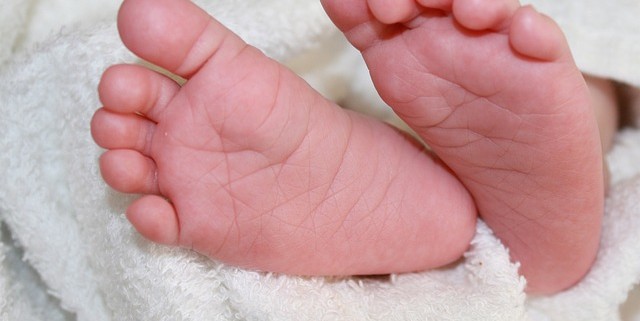Breech Presentation: Babies Born Backwards

Contents
What Is Breech Presentation?
Essentially, breech presentation is when your baby is in a foot-first or bottom-first position when you go into labor. There are a couple of different types:
- Frank Breech: The baby’s bottom is pointing toward the birth canal with legs extended and feet up near the head
- Complete Breech: The baby’s bottom is pointing toward the birth canal with legs crossed
- Footling Breech: One or both feet are pointing toward the birth canal
What Causes A Breech Presentation?
In most cases, it’s not possible to determine the reason a baby doesn’t flip into a vertex position. However, there are certain factors that increase the risk of a breech presentation. Most notably, you’re more likely to have a breech baby if you’ve already had a breech baby, if you have placenta previa, or if you’ve had a c-section before. Premature babies are also more likely to be breech, since they haven’t had time to flip around yet.
Babies may end up in the breech position due to abnormalities of the uterus or umbilical cord that limit the baby’s range of motion. If you have too much or too little amniotic fluid, that can also lead to a breech presentation since the baby either has too much or too little room to move. Finally, twins and other multiples may end up in a breech position because they don’t have room to flip.
How Does It Affect The Baby?
Delivery is simply more difficult when the baby is breech. It’s harder for the baby to get through the birth canal bottom- or feet-first. It can also put strain on the baby’s joints as the arms and legs can get tangled up and stretched into unusual positions over the course of delivery. Sometimes, the baby’s head can get stuck in the birth canal in a breech delivery. In many cases, vaginal delivery isn’t possible at all – about 90% of breech babies end up being delivered by c-section.
The main risks to the baby of a breech presentation come with vaginal delivery. As mentioned above, the baby’s limbs can be strained or injured and the head may, in rare cases, get stuck in the birth canal. The baby’s arms or legs may even be fractured during delivery.
In addition, a breech delivery is usually more difficult than a vertex delivery. This may stress the baby and increase the risk of premature meconium release, which can lead to meconium aspiration syndrome.
A breech delivery also increase the risk of umbilical cord prolapse. The umbilical cord may slip down lower in the uterus during delivery and get pinched as the baby’s legs or bottom move into the birth canal, limiting the supply of oxygen to your little one. Fetal oxygen deprivation can cause brain damage and other health problems.
Breech babies also have a slightly higher likelihood of having a birth defect, although it’s not clear whether this is a cause or effect of their position during delivery.
Diagnosing And Treating A Breech Presentation
Babies move around all the time over the course of your pregnancy and most, if not all, of them are in a head-up position at some point over those 40 weeks. Toward the end of your pregnancy, usually around 32-38 weeks, your little one will start to flip around in preparation for labor. As you approach your due date, your doctor will regularly check on the position of your baby. She’ll feel around on your belly to determine if the head is up or down. She may also do an ultrasound to confirm the baby’s position.
If you get to around 37 weeks and the baby is still head-up, your doctor may attempt to manually reposition your little one. This is called an “external cephalic version” (ECV). You’ll receive medicine to relax your uterus and the doctor will gently push and pull on your belly to help get the baby to turn. It’s generally not painful, although it may be uncomfortable. An ECV works more than half the time, although babies sometimes flip back afterward.
The closer you get to your due date, the harder it is to reposition the baby. There’s less and less room to move around in your uterus. Sometimes, the baby will flip into a vertex position just a few days before labor, so it can be hard to tell whether a breech presentation is going to be an issue or not until the big day.
Delivery Day
If you go into labor and your little one is still in a breech presentation, you’ll need to work with your doctor to decide what the best plan is for you and the baby. If your water hasn’t yet broken, your doctor may attempt one last ECV to get the baby in position for a vaginal delivery. If your water has broken or if you’re having contractions, an ECV won’t be possible.
If your little one is in the wrong position going into delivery, your doctor is likely to recommend a c-section. Some doctors and midwives will attempt a vaginal birth with certain breech babies, but vaginal delivery with a breech baby come with a higher risk of injury to the child and to you. If you do decide to attempt a vaginal delivery, you may still need an emergency c-section if the baby gets stressed or stuck.
If your doctor or other medical care provider attempts a vaginal delivery and your little one is injured, you may be entitled to compensation for the injuries. The Safe Birth Project may be able to help with this and other legal questions about birth injury.
Be Prepared
The vast majority of babies end up in the proper vertex position by the time mom goes into labor, but it’s important to be aware of the possibility of a breech presentation and what it means for your birth plan. If you’re planning to deliver in a birthing center or at home, be sure to ask your midwife about how you’ll handle a breech birth. Most midwives and birthing centers don’t have the ability to handle a breech birth because of the risk that you’ll need an emergency c-section and will recommend that you go to the hospital instead.
As always, the key is to stay in contact with your doctor throughout your pregnancy so that you can make the best decision for you and your little one.








Leave a Reply
Want to join the discussion?Feel free to contribute!